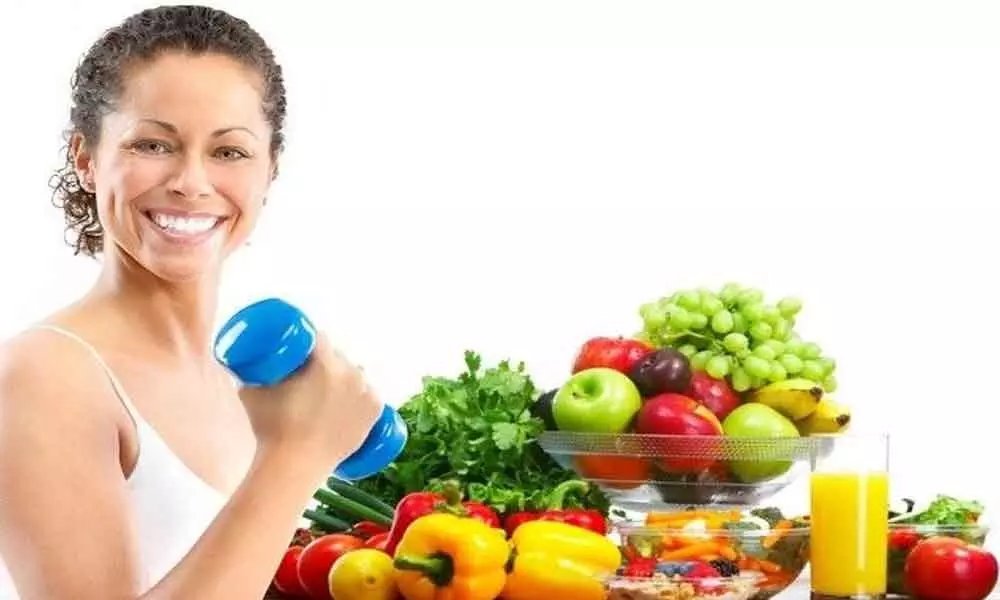Live
- They always want me to win, and now I feel lucky to have been offered a story like ‘Zebra’: Satyadev Kancharana
- ‘Democracy first, humanity first’: PM Modi in Guyana's parliament on two countries' similarities
- PKL Season 11: Telugu Titans register third straight win to top standings
- Is Pollution Contributing to Your COPD?
- NASA Unveils Underwater Robots for Exploring Jupiter's Moons
- Additional Central forces arrive in violence-hit Manipur
- AR Rahman and Saira Banu’s Divorce: Legal Insights into Common Issues in Bollywood Marriages
- 82.7 pc work completed in HPCL Rajasthan Refinery area: official
- Curfew relaxation extended in 5 Manipur districts on Friday
- Tab scam prompts Bengal govt to adopt caution over fund disbursement
Just In

The nutritional needs of a female body differ according to the various phases of life -- adolescent (teenage) stage to an adult woman; and finally up...
The nutritional needs of a female body differ according to the various phases of life -- adolescent (teenage) stage to an adult woman; and finally up to the elderly person (geriatrics). And therefore, one has to be really mindful of taking an adequate amount of nutrition for healthy living.
Sheela Joseph, Senior Dietician, Sparsh Hospitals, underlines the different nutritional needs and their sources.
Adolescent:
Adolescent or teenage years is a transition between childhood and adulthood, this is about the same period puberty sets in young girls (10 to 13 years). Adolescence is characterized by growth spurts.
Nutrition deficiency experienced during this critical period can have adverse effects on their adult life – malnourished young girls turn to malnourished young women, who then give birth to unhealthy underweight babies.
Energy protein, calcium, and iron are the most important nutrients in this stage. The sufficient amount of whole grains, serials, pulses, and nuts from a balanced diet meets the energy requirement. Proteins from animal sources- eggs, meat, fish, chicken are of higher biological value and are better observed and utilized by the body. Plant-based proteins from dairy such as milk, yogurt, cheese, paneer (cottage cheese), and proteins from whole pulses, nuts, and soy (tofu, tempeh, miso) are recommended.
Iron is vital for the transportation of oxygen in the blood, the deficiency of iron causes anemia which can cause breathlessness, giddiness, fatigue, confusion, and weakness. Adoldesnces is a stage for rapid growth which increases the blood volume and muscle-mass and hence an increased requirement of iron. Menstruation causes young girls to lose blood and if they are not taking a healthy diet they will become anemic.
Including foods rich in iron like eggs, meat, etc. are better observed by the body as they are from animal sources. Greens, whole grains and legumes and millets, dates, figs, raisins, jaggery, are few common foods rich in iron and should be consumed on a daily basis.
Squeezing a lime over the cooked foods rich in iron before consumption will help the observation of iron by the body as vitamin c from line helps in the observations of iron.
Calcium – 45 percent of the bone mass is attained during the adolescents and hence adequate calcium intake is important during this stage.
Dairy sources like Milk, Yogurt, Cheese, Panner and seeds like sesame seeds are rich sources of calcium. Greens, dals, pulses, and millets are also good sources of calcium. Vitamin d is a very important factor necessary for the absorption of calcium. Exposing large body surface area to sunlight for about fifteen minutes between 10 am to 3 PM helps in the formation of vitamin d in the body.
Good food sources of Vitamin D from food are cod liver oil, salmon, tuner, liver, egg yolks, and sardines. Other sources include certain mushrooms, fortified orange juice, and Soya, almond milk fortified with vitamin D.
Nutrition in an adult woman:
Here the challenge is to maintain a healthy weight. One has to reduce calories from fats and carbohydrates and increase the consumption of vegetables and fruits.
A good exercise is very necessary to ward off the extra weight which starts piling on if one is not careful.
As an adult woman, her body needs to be healthy for childbearing. Pregnancy and lactation make more demands on the body of a young woman.
The recommended daily allowance for pregnant and lactating women is more when compared to a normal adult woman, in terms of calories, proteins, calcium, and iron.
Older-woman:
Body composition changes with advancing age and these changes affect the nutritional needs of an older woman. As women grow older they need fewer calories to maintain the weight, the choice of low fat and high fiber food is a must. Cooking oil to be reduced to 15 to 20 gms per day.
Foods cooked with hydrogenated fats like shortcrust pastries (puffs, croissants, etc...), bakery products should be avoided.
Salt used in cooking per day can be reduced to half to three fourth teaspoon per day (2.5 to 3 gms/ day). All naturally salted foods like papads, pickles, chips, etc., should be taken in a very limited amount.
In postmenopausal women, estrogen level fall and this hormones' protective function of the heart decreases and makes the women most susceptible to heart diseases. Lowering of the estrogen levels in the elderly woman also causes bone loss. So, older women have to take care to avoid osteoporosis. calcium intake through diet and or supplementation is a must. Strength exercise or resistance training is a must to increase bone density and reduce the risk of osteoporosis.
Whole grains, millets, pulses, high-fiber vegetables, fresh fruits, low-fat curd or paneer and seeds like sunflower seeds, flake seeds, chia seeds, pumpkin seeds and nuts like almonds and walnuts/ are to be regularly included in the diet.

© 2024 Hyderabad Media House Limited/The Hans India. All rights reserved. Powered by hocalwire.com







